9 Basic Yoga Poses For Beginners
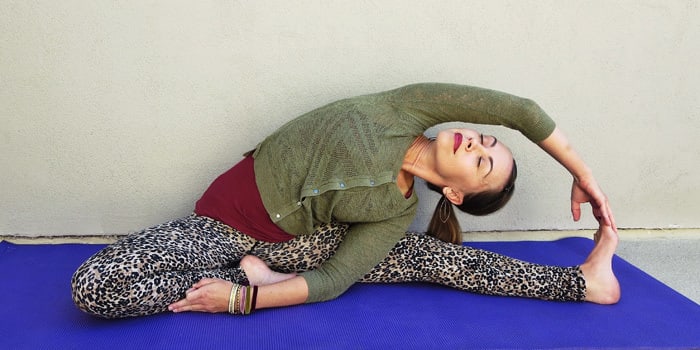
Yoga is all the rage for people of any age, but the younger yogis seem to be intimidating everyone with their need to show off how flexible they are.
This ancient activity is meant for all shapes, sizes, ages, and genders, so don’t be intimidated by the show-offs.
Start with the basics, from the floor up, so to speak. Here are 9 basic yoga poses that almost any beginner can accomplish.
9 Basic Yoga Poses For Beginners
1. Child’s Pose (Balasana)
Let’s start with a restorative asana that doesn’t require you to throw your feet over your shoulders or anything like that.
Balasana is a relaxing pose that will calm your mind and restore the blood flow to the internal organs.
Benefits: Stretches the ankles, hips, spine, and arms. Encourages deeper breathing, relaxes the mind, and relieves tension and anxiety. Regulates blood flow throughout the body and keeps your internal organs young and healthy.
How To: Begin on your hands and knees on the mat. Un-tuck your toes and bring the feet together.
Spread your knees out a bit further than hip-distance apart and sit back on your heels. Extend your arms all the way out and lie your forehead on the mat. Hold 8-10 breaths.
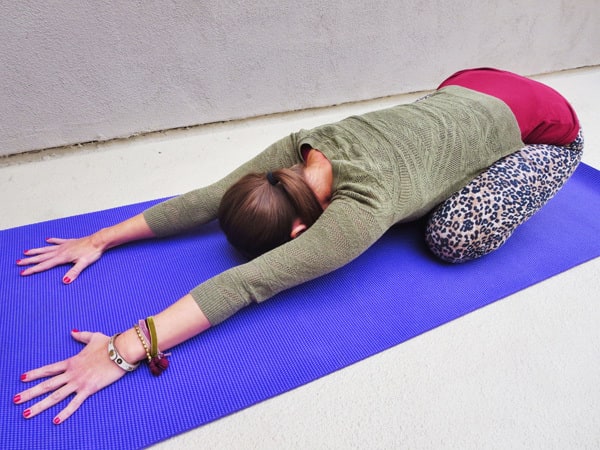
2. Seated Forward Fold (Paschimottanasana)
Hamstrings can be among the tensest muscles in your body, especially if you have a job that requires you to sit 8 hours a day.
This pose is ideal for those who have sore lower backs and tight leg muscles. It’s easy to do and should be done several times a day to keep your lower body flexible and pain-free.
Benefits: Stretches the hamstrings, spine, and shoulders. Lowers blood pressure, and relieves headaches, lower back pain, and symptoms associated with menstrual pain. Decreases depression and anxiety. Stimulates the liver, kidneys, and reproductive organs.
How To: Begin seated on the mat with your legs together fully extended in front of you.
Pull the flesh away from your sits bones so you are fully able to feel the floor beneath you.
Tuck your toes in so the leg muscles engage and turn your inner thighs down toward the floor. Keep your spine straight, lifting your sternum toward the ceiling and walk the hands down the sides of your legs.
Stop when you feel a stretch. Hold 8-10 breaths.
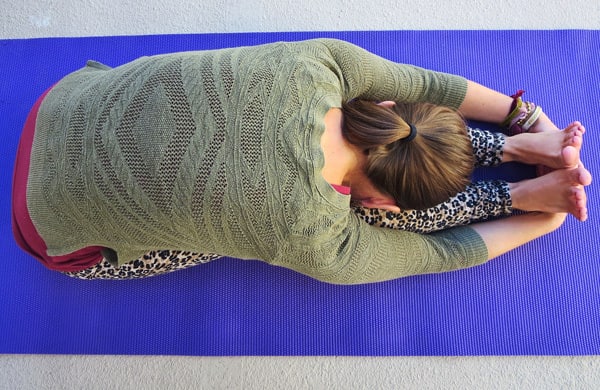
3. Bridge Pose (Setu Bandhasana)
If you are feeling worn out, this pose is the ticket to rejuvenation. It is a simple pose that holds many benefits for the body and mind, leaving you feeling great.
Benefits: Stretches the neck, shoulders, chest, and spine. Wakes up the organs in your abdomen, activates the thyroid gland, and opens the lungs.
Relieves back pain and menstrual cramps. Strengthens bones and lowers blood pressure.
How To: Lie flat on your back, bend your knees, and walk your feet in until you can brush your heels with your fingertips. Keep feet and knees hip-distance apart during the whole pose.
Press your feet and arms (laying beside you) into the floor to lift your bottom off the ground. Keep the knees over the ankles and engage inner thighs to stabilize.
To go deeper, roll your shoulders under you and interlace your fingers together below the pelvic cavity.
Actively reach through the arms while pressing into the shoulders to lift higher. To release, keep your tailbone tucked in and slowly lower your vertebrae by vertebrae.
Your bottom should be the last thing to touch the ground. Hold 8-10 breaths.
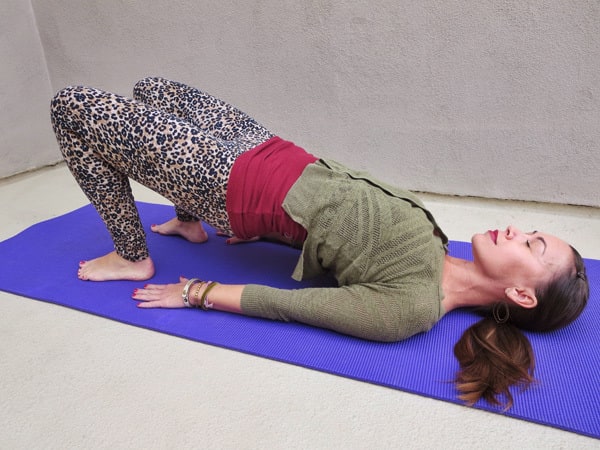
4. Wide-Angled Seated Forward Bend (Upavistha Konasana)
Tight hips can wreak havoc on the lower back and decrease the amount of fluidity in your stride. Spend plenty of time in this asana, as it takes plenty of time to loosen up this area in the body.
Benefits: Releases tension and stretches the legs (inside and outside), groin, and spine. Activates the internal organs, keeping them young and supple. Strengthens the back. Calms the central nervous system, and slows heart rate.
How To: Sit on the mat, spreading the flesh away from your sitz bones for proper grounding structure; spread your legs out as far as possible, reaching the heels to the inside corners of the mat.
Tuck the toes in (flexing the feet) so that the muscles in the legs activate. Sit up tall, keeping the spine straight as you lift through your sternum.
Place the hands on the floor and slowly walk them forward until your feel a stretch in the groin, hamstrings, and lower back. Hold 8-10 breaths.

5. Seated Spinal Twist (Bharadvajasana 1)
Come on baby…let’s do the twist. Why? Twists are one of the things in yoga that keep our innards young and healthy.
It’s a common yogic belief that when we massage our organs with twists and asanas we wring out all the toxins, old blood, and stale oxygen so that we can replace with the fresh and new.
Benefits: Stretches the hips, waist, spine, chest, shoulders, and neck. Massages the internal organs in the stomach. Encourages proper digestion and decreases stress.
How To: Sit cross-legged on your mat. Move the flesh away from your sitz bones and sit up very tall with a straight spine.
Take your right hand to the left knee and rest the left hand behind you. Relax your shoulders, relax your stomach, and take your gaze over the left shoulder to stretch the neck.
Hold 8-10 breaths, then turn to other side.
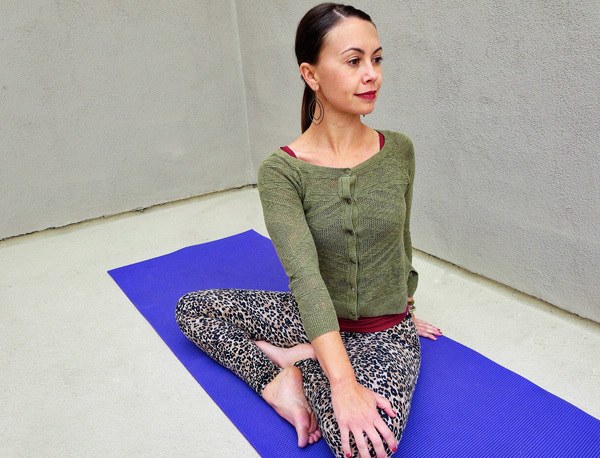
6. Reclining Goddess Pose (Supta Badha Konasana)
This pose is a hip opener and can be restorative or intense, depending on the props you use.
Benefits: Stretches the groin, knees, and inner thigh muscles. Improves blood circulation. Calms the mind, relieves menstrual cramping and symptoms of menopause. Stimulates internal organs in the abdomen.
How To: Begin the pose by lying on the floor. Relax the stomach, chest, shoulders, and spine. Bend your knees and put your feet flat on the floor.
Place your feet together and splay the knees open. If the hips and groin are too tight, place blocks or a blanket under your knees or hips to support them.
Take the hands to your stomach or rest them beside you. Hold 8-10 breaths.
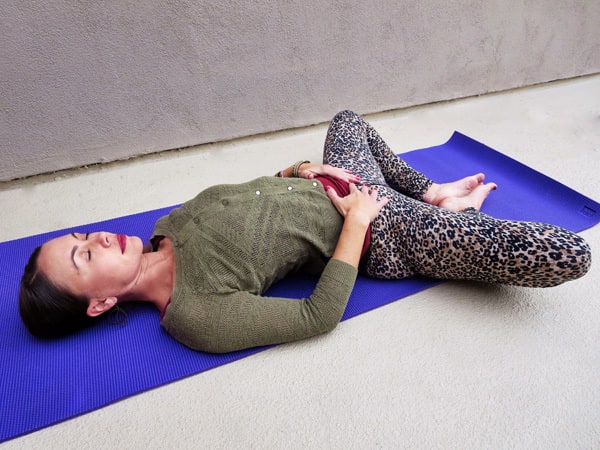
7. Bound Ankle Pose (Baddha Konasana)
Want to soften up those tight hips? Then put yourself in a bind, literally. This pose is easy to accomplish. You just hold onto your feet, butterfly your legs open, and fold. Voila! Softer hips in no time flat.
Benefits: Relaxes the inner thighs, groin, and knees. Stimulates the abdominal organs and heart. Helps relieve symptoms of depression, anxiety, menopause, menstruation, and sciatica.
Improves blood circulation, gives you energy, and helps smoother delivery during labor.
How To: Park yourself on the mat, pull the flesh away from the sits bones and sit tall with a straight spine.
Bend the knees and bring the soles of your feet together. Separate the inside edge of your feet as if you are opening a book, which will help to splay your knees open.
Grab hold of the ankles, lead with the sternum, and fold forward toward the feet. Keep the spine straight and the shoulders pulled back. Hold 8-10 breaths.
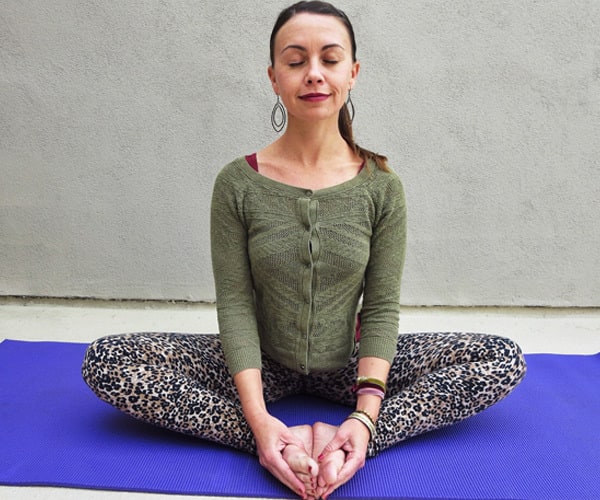
8. Revolved Head To Knee Pose (Parivrtta Janu Sirsasana)
This pose gives you a beautiful, whole body side-stretch The best time to do this pose is when your body is warmed up so you can go as deep as possible without hurting yourself.
Benefits: Strengthens the leg and core muscles. Improves digestion. Stretches the hips, spine, shoulders, waist, and hamstrings. Calms the mind and body. Stimulates abdominal organs.
How To: Begin in a seated position on the mat with the legs spread out horizontal as far as they will go.
Pull the right foot in toward the pelvic cavity and the inner portion of the left thigh. Flex your left foot to engage the muscles in the legs.
Sit up tall, lengthening the spine, and reach your right arm toward the left straight leg. Relax your left shoulder, keeping it away from the ear and look up to stretch the neck.
Hold 8-10 breaths, then switch to other side.

9. Corpse Pose (Savasana)
Easiest pose to get into, but some say for westerners it’s the hardest pose to accomplish.
The proper purpose of the pose is to completely relax and let go which is pretty hard for Type A, overachieving, constantly moving, and getting-stuff-done society.
However practice makes perfect and this is 100% necessary to keep yourself balanced.
Benefits: Lowers blood pressure. Relaxes the body and mind. Slows heart rate. Relieves headaches, stress, and anxiety.
How To: Lie down flat on your back. Spread your arms out away from the torso, turn the palms face up and relax your shoulders away from the ears.
Separate the legs so the heels work their way to the inside corners of your mat. Close your eyes, relax your jaw, and slow your breath down. Relax!

For more beginner yoga poses, check out 3 Week Yoga Retreat on BODi, in which four yoga experts guide you through the foundations of yoga.
All photos by Lulu Lam.
